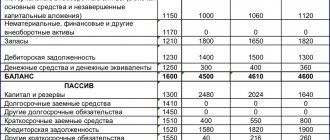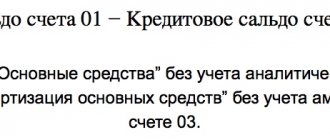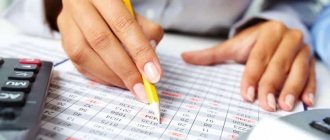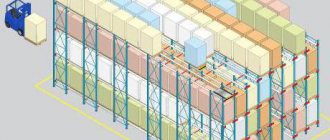All-Russian classifier of units of measurement
Every day, any organization produces a huge number of documents. Sometimes, in order to save time, space on a document and make it understandable for a large number of users, special codes are used.
Our country has developed a Unified Classification System, which includes many codes used in all spheres of the economy.
The classifier includes the following groups of units:
- Economic
- Technical
- Masses
- Volume
- Time
- Square
- Lengths
The classifier was approved by Gosstandart Decree No. 366 dated December 26, 1994 with the latest amendments and is associated with GOST 8.417-81 (as amended by Rosstandart Order No. 1101-st dated September 26, 2013.
All data contained in the classifier must be used by specialists in full accordance with it, without deviation.
If the required code is not in the generally accepted classifier, you can add your own values for use in a specific company, which are understandable to the counterparty. For example, the Classifier does not have such a unit of measurement as “Service”. Someone measures services in units, which is probably not very correct, someone adds such a name to their internal classifier. Many people simply put dashes in the corresponding columns of documents when providing services.
The codes contained in the classifier are also used in the preparation of annual financial statements. Let's take a closer look.
Balance structure
Before we begin to consider such issues, it should be noted that the balance sheet allows you to make a forecast of the development of the enterprise for the short and long term. In other words, using the balance sheet, the financial viability of the company and its economic status, the stability of the organization and the level of its interaction with other companies are determined.
The balance sheet has a certain structure. The document contains two tables. The first table is the company's assets, and the second is the liabilities:
An asset can include all the property of an enterprise that can be converted into monetary terms. The group of such assets includes: equipment, vehicles, buildings that are owned by the company. The company's assets also include amounts owed to it by other legal entities. All indicated indicators are displayed in the balance sheet in monetary terms. In other words, an asset is all the property and property that an enterprise has at its disposal.
The asset has its own structure, within which non-current assets are indicated. This group includes the means that the enterprise uses for a long time to carry out business activities - these are buildings, structures, equipment. The second section of assets is current assets, which denote the amount of funds that are used by the company for a short period and constantly need replenishment - these are materials, inventories, raw materials:
The liability is used to display the sources of funds that are indicated in the Asset of the balance sheet. This section also has its own structure and includes the following blocks: the authorized and equity capital of the company, loans and credits, external liabilities. The three main sections are called:
- funds belonging to the company;
- the amount of long-term liabilities;
- wages and accounts payable to suppliers.
The main task in drawing up a balance is to achieve equality between these two parts. The document is drawn up according to Form 1, approved back in 2010. This form is rather a recommended document and can be modified due to the specifics of the enterprise. To make it clear how the balance is calculated, we give a simple example:
What is the balance sheet of an organization
The balance sheet is one of the most important and sought-after documents of the company.
All information that is reflected in accounting during the year is ultimately consolidated into one document - the balance sheet of the organization. This is one of the integral (and most important) parts of the company’s entire annual reporting. .
Balance is required by many users. Among them:
- Owners of the company
- Banks
- Organization partners
Using the report indicators, you can assess the level of development of the company and, importantly, its financial condition.
The report is a tabular form consisting of two large parts - assets and liabilities. An asset reflects everything that an organization owns, and this is not only property, but also, for example, accounts receivable or financial investments of the company. The liability reflects all sources of the organization's assets, for example, such as various types of capital (mainly authorized capital) or the organization's accounts payable.
Of course, there must be mandatory equality between assets and liabilities. Otherwise, the report was compiled incorrectly and something was missed.
Filling out your balance in 2021
A report for 2021 is generated on the basis of data on accounting accounts for the year. Balance sheet indicators are presented in a form “cleared” of regulatory values: for example, the cost of fixed assets and intangible assets is indicated without taking into account depreciation, the amount of inventory items is indicated minus the accrued reserve for the depreciation of inventory items and trade margins, cash – without the amounts of deposits recorded in financial accounts investments. Accounts payable and receivable are reflected in detail.
The basis for drawing up a balance sheet is the account balances combined by the turnover balance sheet (SAS) as of a certain date. The table below shows which accounting data forms the value in each balance sheet line:
| Balance line | It is formed based on the balance of accounting accounts: | Calculation of value (according to accounting accounts) | ||
| D/t | K/t | |||
| Section I | ||||
| 1110 | 04 | 05 | D/t 04 – K/t 05 | |
| 1120 | 04/R&D expenses | |||
| 1130 | 08/search assets | 05/search assets | ||
| 1140 | 08/materials and materials for search assets | 02/search assets | ||
| 1150 | 01, 08 | 02 | D/t 01 – K/t 02 + D/t 08 | |
| 1160 | 03 | 02/depreciation on profitable investments | D/t 03 – K/t 02 | |
| 1170 | 55, 58, 73/personnel loans | 59/reserves for obligations | L/t 73 + D/t 55 + D/t 58 – K/t 59 | |
| 1180 | 09 | D/t 09 | ||
| 1190 | amounts of other non-current assets not included in previous items | |||
| 1100 | Total | Sum of lines from 1110 to 1190 | ||
| Section II | ||||
| 1210 | 10, 11, 15, 16, 20, 21, 23, 29, 41, 43, 44, 97 | 42, 14 | The amount of debit balances reduced by credit balances of the account. 42 and 14 | |
| 1220 | 19 | |||
| 1230 | 60, 62, 63, 66, 68, 69, 70, 71, 73 (except for long-term interest-bearing loans), 75, 76 | 63 | The sum of debit balances minus K/t 63. This is how the reliability of balance sheet data is achieved | |
| 1240 | 58, 73/Loans | 59 | L/t 58 – K/t 59 + D/t 73 | |
| 1250 | 50, 51, 52, 55, 57 | Sum of account balances | ||
| 1260 | Other assets not included in previous items | |||
| 1200 | Total | Sum of lines from 1210 to 1260 | ||
| 1600 | Total asset – the sum of the results for sections I and II | Sum of lines 1100 and 1200 | ||
| Section III | ||||
| 1310 | 80 | K/t 80 | ||
| 1320 | 81 | D/t 81 | ||
| 1340 | 83/Additional assessment of fixed assets and intangible assets | K/t 83 | ||
| 1350 | 83/excluding undervaluation | K/t 83 | ||
| 1360 | 82 | K/t 82 | ||
| 1370 | 84 | K/t 84 | ||
| 1300 | Total | Sum of lines from 1310 to 1370 | ||
| Section IV | ||||
| 1410 | 67 | K/t 67 | ||
| 1420 | 77 | K/t 77 | ||
| 1430 | 96 | K/t 96 | ||
| 1450 | other | |||
| 1400 | Total | Sum of lines from 1410 to 1450 | ||
| Section V | ||||
| 1510 | 66, 67 | K/t 66 + K/t 67 | ||
| 1520 | 60, 62, 68, 69, 70, 71, 73, 75, 76 | Amount of credit balances on accounts | ||
| 1530 | 98, 86 | K/t 86 + K/t 98 | ||
| 1540 | 96 | K/t 96 | ||
| 1550 | values not included in other articles in the section | |||
| 1500 | Total | Sum of lines from 1510 to 1550 | ||
| 1700 | Total liability - the sum of the totals for sections III - V | Line sum 1300, 1400, 1500 | ||
The totals of lines 1600 and 1700 should be equal. Compliance with this criterion confirms the correctness of the generated report data.
We talked in more detail about deciphering balance lines here.
Unit code 384 in balance sheet
According to paragraph 16 of PBU 4/99, the company’s annual reporting is prepared in Russian currency, that is, in rubles.
Depending on how large the balance sheet indicator is, it is more convenient to indicate the values of the indicators in rubles, thousands of rubles, millions of rubles and even billions (which is very rare). Each organization decides which units of measurement to use independently. .
Of course, the most often used unit of measurement is a thousand rubles, since organizations in which it is possible to keep records of indicators in millions are several times smaller.
| Code | Explanation of the name |
| 383 | Ruble |
| 384 | Thousand rubles |
| 385 | One million rubles |
Therefore, most organizations use balance sheet measurement code 384.
This code is entered in the “Units of Measurement” line. It looks like this:
As you can see, units of measurement are written in words, abbreviated as “thousands”. rub.”, and the code is placed in the corresponding cell of the form.
Reflection of assets and liabilities
When filling out the balance sheet lines, follow Section IV of PBU 4/99. That is, take into account the timing of assets and liabilities. Show assets and liabilities with a maturity period of more than 12 months as long-term. All other assets and liabilities are current.
If a specific balance sheet line is not defined for assets (liabilities), reflect them based on their economic substance. This must be done regardless of which account they are accounted for (clause 6 of PBU 4/99, paragraph 2 of clause 10 of the Regulations on Accounting and Reporting). For example, despite the fact that the deposited salary is accounted for in account 76 (and not in account 70), its economic content does not change. Therefore, in the balance sheet, reflect the deposited salary as accounts payable to personnel, and not to other creditors.
Reflect the value of property and liabilities in the balance sheet minus regulatory values. In particular, the control quantities are:
- the amount of accrued depreciation (letter of the Ministry of Finance of Russia dated January 30, 2006 No. 07-05-06/16);
- reserve for reduction in the value of material assets (clause 25 of PBU 5/01);
- reserve for depreciation of financial investments (paragraph 5 of clause 38 of PBU 19/02);
- reserve for doubtful debts (letter of the Ministry of Finance of Russia dated December 23, 2005 No. 07-05-06/353).
Do not indicate the balance of reserve accounts separately in the balance sheet. Reduce the indicators of the corresponding lines by these amounts. For example, the balance on account 63 “Provision for doubtful debts” reduces the value of the indicator on line 1230 “Accounts receivable”.
Other regulatory values are reduced in a similar manner to the corresponding balance sheet lines. Thus, the cost of fixed assets and intangible assets is indicated minus accrued depreciation. And the cost of inventories is minus the reserve for a decrease in the value of material assets. Reduce the cost of financial investments by the amount of the reserve for depreciation of financial investments. Information on regulatory values is reflected in the Explanations to the Balance Sheet and the Statement of Financial Results. This procedure is established by paragraph 35 of PBU 4/99.
See an example of filling out a balance sheet.
See an example of preparing a balance sheet for a small business.
Situation: on which line of the Balance Sheet should the issued interest-free loans be reflected?
Interest-free loans are reflected in the balance sheet on line 1230 “Accounts receivable”.
Interest-free loans cannot be reflected in the balance sheet on line 1170 “Financial investments”. After all, such loans do not bring income to the organization, and therefore are not financial investments.
This conclusion can be drawn from paragraph 4 of paragraph 2 of PBU 19/02.
Information on line 1230 can be detailed (clause 19 of PBU 4/99). For example, depending on the expected maturity of the debt: within the next 12 months - short-term, in more than 12 months - long-term. Or depending on who the debtor is - an organization or a citizen.
Requirements for the company's balance sheet
All the basic requirements for financial statements are enshrined in regulations:
- The first such act is the Law “On Accounting”. This is a fundamental document, which in article 13 sets out how reporting should be compiled
- Order of the Ministry of Finance No. 34n dated July 29, 1998, as amended in 2018. Articles 30 to 40 provide general information about the composition of the report
- PBU 4/99, paragraphs 6 to 17 reflect the reporting procedure
In addition to the standard design requirements, the following main ones can be noted:
| Requirement | Explanation |
| Reliability and completeness | Annual reports must be reliable and contain complete information about the company’s activities |
| Neutrality | Information in the forms should be neutral, that is, it should not influence the decisions or assessments of those individuals who are its users |
| Subsequence | The composition must be consistent. One form must be drawn up taking into account the indicators of the other |
| Comparability | Reporting indicators reflected for several periods must be comparable |
| Report period | The balance sheet is compiled as of December 31, other forms for the year as a whole |
Balance sheet: sample for 2021
Let's draw up a balance sheet for 2021 using the accounting data of Leto LLC, grouped in SALT as of 12/31/2019. Let’s say the company has been operating since 2021, is engaged in trade and production activities and is preparing a balance sheet for the first time. The SALT contains the following indicators for accounts:
| Accounting account | Balances as of December 31, 2019 in thousands of rubles. | Notes | |
| By debit | By loan | ||
| 01 | 1200 | OS | |
| 02 | 590 | OS wear and tear | |
| 04 | 220 | NMA | |
| 05 | 100 | Wear and tear of intangible assets | |
| 08 | 100 | Capex | |
| 10 | 400 | Inventory | |
| 14 | 40 | Reserve for depreciation of valuables | |
| 19 | 32 | VAT on purchased assets | |
| 20 | 200 | Unfinished production | |
| 41 | 320 | Goods | |
| 44 | 42 | Sales costs | |
| 50 | 40 | Money in the cash register | |
| 51 | 230 | Cash in the current account | |
| 55 | 100 | Deposit on a special account | |
| 58 | 176 | Short-term financial investments | |
| 59 | 20 | Reserve for depreciation of financial investments | |
| 60 | 250 | 820 | PoK/tu – debt to suppliers, according to D/t - advances paid to them |
| 62 | 520 | 180 | According to D/t - debt of buyers, according to K/t - the amount of advances received from them |
| 63 | 30 | Provision for doubtful debts of debtors | |
| 66 | 20 | 750 | For K/t - a short-term loan with interest on it, For D/t - overpayment of interest |
| 68 | 56 | 280 | According to K/t - debt to the budget, according to D/t – VAT refundable |
| 69 | 38 | 260 | For K/t - arrears of contributions to extra-budgetary funds, for D/t - the amount of compensation from the Social Insurance Fund |
| 70 | 380 | Wage arrears | |
| 71 | 40 | 10 | By D/t – the amount issued for reporting, according to K/t – debt to personnel on advance reports |
| 76 | 33 | 223 | For D/t – VAT on advances received, for K/t – deposited salary and debts on claims |
| 80 | 200 | Authorized capital (AC) | |
| 82 | 60 | Reserve capital | |
| 84 | 135 | retained earnings | |
| 97 | 61 | Future expenses | |
| Total | 4078 | 4078 | |
Based on the given calculation algorithm and accounting data, we will form a balance . The counting and numeric values in the lines when filling out the balance (a sample is given below) will be as follows:
| Line | Account balances according to SALT | Calculation (thousand rubles) | Amount in thousand rubles. |
| 1110 | 04 — 05 | 220 — 100 | 120 |
| 1130 | 08 | 100 | 100 |
| 1150 | 01 — 02 | 1200 – 590 | 610 |
| 1170 | 58 — 59 | 176 — 20 | 156 |
| 1210 | 10 +20 + 41+ 44+ 97 — 14 | 400+200+320+42+61-40 | 983 |
| 1220 | 19 | 32 | 32 |
| 1230 | 60 + 62 + 66 + 68 + 69 + 71 +76 — 63 | 250+520+20+56+38+40+33- 30 | 927 |
| 1240 | 55 | 100 | 100 |
| 1250 | 50 + 51 | 40+230 | 270 |
| Assets | 3298 | ||
| 1310 | 80 | 200 | 200 |
| 1360 | 82 | 60 | 60 |
| 1370 | 84 | 135 | 135 |
| 1510 | 66 | 750 | 750 |
| 1520 | 60 + 62 + 68 + 69 + 70 + 71 + 76 | 820+180+280+260+380+10+223 | 2153 |
| Passive | 3298 |
A simple formula will help you check the adequacy of the result obtained - the total value of turnover (debit or credit) for SALT should be reduced by the summed indicator of regulated accounts (02, 05, 14, 59, 63). The resulting value is a control value; it must be equal to the calculated asset or liability indicator of the balance sheet.
In the example presented, this figure is 3298 thousand rubles.
Check using the formula: 4078 – 590 – 100 – 40 – 20 – 30 = 3298 thousand rubles, i.e. the balance is drawn up correctly.
Planned changes in 2021 – 2021 in annual reporting
Changes to the rules for filing annual reports are planned in the near future.
First of all, it is worth noting that the obligation to submit reports to the statistics service has been canceled for the 2021 report. Now the balance sheet and all related reports are sent only to the tax office.
Starting from the 2021 report, reporting is prepared in thousands of rubles.
On the first sheet of the report the code of the type of activity is entered in accordance with OKVED 2.
From 2021, the form of the financial results report will change. Some lines will disappear and several new ones will appear.
In general, no fundamental changes are planned in the annual reporting.
Interrelation of the balance sheet with other forms of reporting
Some balance sheet lines must be equal to lines from other forms of financial statements. Let's consider this relationship using the formulas, where BB is the balance sheet, FFR is the financial results statement, OIC is the statement of changes in capital, ODDS is the cash flow statement.
- Line 1370 BB = Line 2400 OFR
- Line 1180 BB (difference between indicators at the end and beginning of the reporting period) = Line 2450 OFR
- Line 1420 (the difference between the indicators at the end and beginning of the reporting period) = Line 2430 OFR
- Line 1130 BB = Line 3100 OIC “Authorized capital”
- Line 1320 BB = Line 3100 OIC “Own shares purchased from shareholders”
- Line 1360 BB = Line 3100 OIC “Reserve capital”
- Line 1370 BB = Line 3100 OIC “Retained earnings (uncovered loss)
- Line 1250 BB = Line 4500 ODDS at the beginning and end of the reporting period
Correctly filling out the balance sheet is an important component of the annual financial statements of an enterprise.
Other codes
Other codes provided by the classifier cannot be entered in reporting forms. Thus, unused ciphers include:
- code 383 (denotes rubles);
- code 386 (introduced for calculation in billions of rubles).
Enterprises can use these codes under one condition: the reporting is not of an official nature and is intended for internal users.
Also see Users of Accounting Statements.
Other codes must also be indicated in reporting documents. Their regulation is within the scope of the following regulations:
- Rosstandart order dated January 31, 2014 No. 14-st, which put into effect OKVED-2 (using these codes to indicate the types of areas of activity in the economy);
- decree issued by Gosstandart on March 30, 1999 under No. 97: it contains the All-Russian classifier by types of ownership;
- order of Rosstandart dated October 16, 2012, registered under No. 505-st: this document records variants of code combinations to reflect the organizational and legal form.
Also see “OKVED and accounting services”.
Read also
26.04.2018
How to fill out item by item and line by line
The document consists of two parts: active and passive. The first reflects information about the company's property. Current assets and non-current assets are shown separately. The second part shows the sources of the company's property formation. It includes three sections:
- capital and reserves of the company;
- its long-term obligations to creditors (for a period of more than a year);
- short-term liabilities of the company (with a maturity of less than one year).
In total, there are 5 sections in the balance sheet: 2 for reflecting property and 3 for information about the sources of its formation.
Each of them is assigned its own digital encoding, which includes four characters. All codes start with “1”. The second digit indicates belonging to a specific section. For example, line “1110” shows the amount of intangible assets available to the company, which is included in the first section.
Line “1370” reflects the company’s retained earnings, which relates to the third section of the document.








